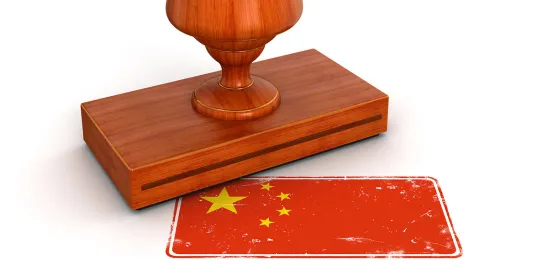On August 3, 2021, the China National Intellectual Property Administration (CNIPA) release the Draft Revised Patent Examination Guidelines (Draft for Solicitation of Comments) (专利审查指南修改草案(征求意见稿)). The draft Guidelines update CNIPA’s current Guidelines based on the newly amended patent law that went into effect June 1, 2021. Discussion of some of the highlights potentially relevant to foreign applicants follows.
Drawings:
Per Part 1 Chapter I: 4.3, while drawings should generally be black and white, “color drawings can be submitted if necessary to clearly describe the relevant technical content of the patent application.”
Requirement for Good Faith and Preliminary Examination for Same:
Per Part One Chapter I: 7.9 the Guidelines state the requirement of good faith in patent application filings and that patent applications will undergo preliminary examination for good faith requirements:
Applying for a patent shall follow the principle of good faith. According to Article 11 of the Implementing Regulations of the Patent Law, in the process of applying for a patent, fabricating, forging, plagiarizing, piecing together or other improper acts are violations of Article 20 Paragraph 1 of the Patent Law.
During the preliminary examination, the examiner shall refer to the provisions of Chapter 1, Section 5 of Part II of these Guidelines to examine whether the conduct in the prosecution of patent application obviously violates the principle of good faith. Obvious violations of the principle of good faith include, but are not limited to, the following situations: simultaneous or sequential submission of multiple patent applications that are obviously identical in content or are essentially formed by a simple combination of different features or elements of different inventions ; patent applications submitted where the invention experimental data or technical effects have been fabricated or forged, plagiarism, simple replacement or patchwork of existing technologies; where the invention-creation for which the patent application is filed is obviously inconsistent with the actual research and development capacity and resource conditions of the applicant or inventor; other irregular patent application related behaviors that violate the principle of good faith and disrupt the normal order of patent work. The examiner shall issue an examination opinion notice, explain the reasons, and notify the applicant to state his opinion within the specified time limit. If the applicant fails to reply within the specified time limit, the examiner shall issue a notice of deemed withdrawal; after the applicant has stated his opinions, the examiner shall make a decision of rejection.
Design Patents
Partial Designs: Per Part I Chapter III: 4.4, partial designs, such as for a tire tread, are now allowed. Dotted lines may be used as in the U.S.
GUIs: For dynamic GUIs, CNIPA may require submission of a video file showing the animation per Part 1 Chapter III: 5.3.
Priority: Design patent applications can now claim priority to either utility models or invention patents per Part 1 Chapter III: 5.2. This will not cause the abandonment of the priority application per 9.3 of Part Four Chapter V.
Delayed Examination: Per 8.3 of Part 5 Chapter VII, design patent examination can be delayed for up to 36 months.
International Designs: A new Part 6 for handling International Design Applications is added indicating that China intends to join the Hague System for International Designs soon.
Patent Term Adjustment (PTA)
According to the second paragraph of Article 42 of the Patent Law, if an invention patent is granted more than four years from the date of the application for the patent for invention and three years from the date of the request for substantive examination, the Patent Office shall provide patent term adjustment.
However, per Part 5 Chapter IX: 2, no PTA will be provided for invention patents when a utility model application for the same invention was filed simultaneously with the invention patent application.
A request for PTA must be filed within 3 months of patent grant.
Like the U.S. practice, “Where compensation is granted for the patent authorization period, the compensation shall be made in accordance with the actual number of days delayed. The actual number of days of delay refers to the unreasonable delay time in the process of granting an invention patent minus the unreasonable delay time caused by the applicant.”
Delays include, for example, extensions taken and delayed examination when requested by the applicant, etc.
Patent Term Extension (PTE)
Patent terms can be extended due to the drug regulatory review process as specified in Part 5 Chapter IX: 3. Note that if there are multiple relevant patents for an approved drug, only one of the patents can be extended per 3.1(5). The request for PTE must be filed within 3 months of received drug marketing authorization. Eligible patents include those for product patents, preparation method patents and medical use patents of the active pharmaceutical ingredient (API) contained in a new drug.
Per 3.6, the calculation method for PTE is: the date when the drug marketing authorization application is approved minus the patent application date (not grant date), and minus 5 years. The compensation period cannot exceed 5 years, and the total effective patent right period after the approval of the drug marketing authorization application cannot exceed 14 years.
Utility Models
In addition to the potential PTA penalty mentioned above for simultaneously filing a utility model and invention patent application, filing both will also cause a 4-year delay in examination in the invention patent application per Part 5 Chapter VII: 8.3.
15-Day Mail Delivery Delay Calculation in Deadlines
Per Part V, Chapter 6, Section 2.3.1, electronically filed applications will no longer be entitled to a 15-day mail delay when calculating deadlines to respond to communications from CNIPA. Accordingly, a second or subsequent or Office Action would only have a 2-month deadline to respond.
A chart showing all proposed changes is available here: 《专利审查指南修改草案(征求意见稿)》修改对照表 (Chinese only). Comments are due September 22, 2021.



 />i
/>i

